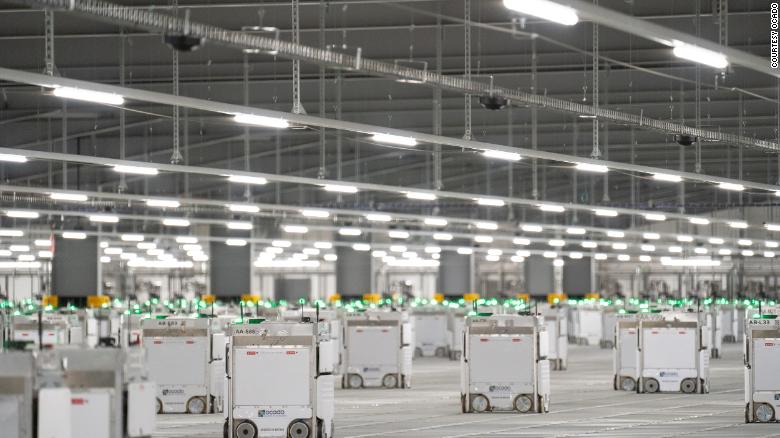
©CNN
Pre-reading questions:
I will read each question. Then, please answer them.
- What is the biggest robotic company in Japan? Tell me more about it.
- Do you like the idea of using robots at home? Why?
Vocabulary:
I will read the words, meanings, and sample sentences. Then, repeat after me.
- objective /uhb-JEK-tiv/
- initially /ih-NISH-uh-lee/
- beneath /bih-NEETH/
- container /kuhn-TEY-ner/
- store /stawr/
[noun] – something that you plan to do or achieve
Our main objective is to improve the company’s productivity.
[adverb] – at the beginning
His illness was initially diagnosed as food poisoning.
[preposition] – in or to a lower position than someone or something, under someone or something
The dog was beneath the table.
[noun] – a hollow object, such as a box or a bottle, that can be used for holding something, especially to carry or store it
Ask the children to guess what’s in each container by putting their hands in.
[verb] – to put or keep things in a special place for use in the future
He stored all of his money in that box.
Article reading:
Please read the whole article. Then, I will check your pronunciation and intonation.
In a warehouse the size of three football fields, 3,000 robots move at 13 feet per second, swerving to avoid each other in a complex dance choreographed by artificial intelligence. What do they want to achieve? The objective is to obtain your groceries as quickly as possible. The warehouse in southeast London, which is equipped with the most advanced automated systems, is run by the British online retailer Ocado. The Ocado Smart Platform (OSP) was created initially for the company’s use, but it has now been licensed to other supermarkets.
The bots, which resemble washing machines on wheels, move across a grid like chess pieces. Each square has a stack of up to 21 containers hidden beneath it. The containers contain some of Ocado’s 50,000 goods, which are stored according to an algorithm that predicts when they will be needed. When the warehouse receives an order, the bots wake up and sprint to the container they need, passing within five millimeters of each other. “We basically play chicken with them: they go on a collision course only to divert at the last moment,” says Alex Harvey, chief of advanced technology at Ocado Technology. The bots are not self-autonomous; instead, they are guided by a system that organizes their pathways for them, akin to air traffic control. Each of the bots has a gripping mechanism and can hold one container. If a product is stored five containers down, for example, four bots will remove the containers above it first, creating room for a “hero” bot who is fulfilling an order.
When the “hero” bot has a container in its grasp, it transfers it to a picking station, where it is selected and added to an order by a person (or another robot, depending on the technology used in each warehouse). Following that, the completed order is transferred to a van for final delivery. “Labor costs are one of the key driving factors in the cost of groceries,” says Harvey, “and our goal is to try to automate these very repetitive, not particularly exciting human operations in the warehouse.”
The bots, which resemble washing machines on wheels, move across a grid like chess pieces. Each square has a stack of up to 21 containers hidden beneath it. The containers contain some of Ocado’s 50,000 goods, which are stored according to an algorithm that predicts when they will be needed. When the warehouse receives an order, the bots wake up and sprint to the container they need, passing within five millimeters of each other. “We basically play chicken with them: they go on a collision course only to divert at the last moment,” says Alex Harvey, chief of advanced technology at Ocado Technology. The bots are not self-autonomous; instead, they are guided by a system that organizes their pathways for them, akin to air traffic control. Each of the bots has a gripping mechanism and can hold one container. If a product is stored five containers down, for example, four bots will remove the containers above it first, creating room for a “hero” bot who is fulfilling an order.
When the “hero” bot has a container in its grasp, it transfers it to a picking station, where it is selected and added to an order by a person (or another robot, depending on the technology used in each warehouse). Following that, the completed order is transferred to a van for final delivery. “Labor costs are one of the key driving factors in the cost of groceries,” says Harvey, “and our goal is to try to automate these very repetitive, not particularly exciting human operations in the warehouse.”
Comprehension questions
I will read each question. Then, please answer them based on the article.
- What does Ocado want to achieve?
- What does OCP stand for?
- Who is Alex Harvey?
- According to the article, how can bots hold one container?
- What is one of the determinants of grocery prices?
Discussion questions
I will read each question. Then, please answer them.
- Have you seen a robot? Tell me more about it.
- What is the most advanced robot that you know today? Tell me more about it.
- Would you like robots to assemble your grocery orders? Why or why not?
- Do you agree with the idea to automate these very repetitive, not particularly exciting human operations in the warehouse?
- What do you think would happen if human jobs were replaced by robots in the future? Please explain your answer.